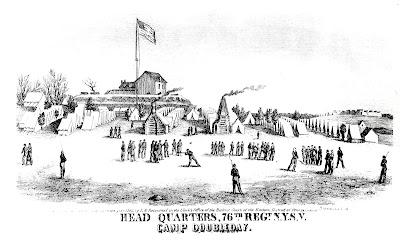 |
The 76th NY was organized in Courtland and Albany New York and manned the Defenses of Washington from March to May of 1862 under the command of Colonel Shaul who commanded five of Washington's earthwork forts. Abner Doubleday after whom the camp was named was their Brigade commander.
Rosenthal's engraving pulls together several threads of interest. It shows an early stage in the development of Fort Stevens and seems to show a baseball game in a camp named for Abner Doubleday a man who most famously did not invent baseball.
See The Man Who Didn’t Invent Baseball in American Heritage Magazine, Vol. 34, Issue 4, June/July 1983. Discussing this image Protoball says:
Warning -- This coincidence is not taken as evidence that Abner Doubleday "invented" base ball.
It has been suggested that this is a proto-baseball game called Drive Ball. The Baseball Almanac defines Drive Ball this way:
A game described in The Boy's Book of Sports (published by Sidney Babcock in New Haven, Conn., 1835) in which two boys with bats face each other, taking turns hitting fungoes to each other. David Block (Baseball Before We Knew It, 2005, p.48 & 198) explained the game: "When one boy hits the ball, the other has to retrieve it as quickly as he can, then fungo it back from the spot he picked it up. The idea was to advance forward by a combination of hitting the ball as far as possible past your opponent and also retrieving the opponent's ball before it could get too far behind you."
Another interesting detail in the above is the man on the far right who appears to be taking a piss.
I wanted you to see the picture of Fort Massachusetts and camp Doubleday and Fort Slocum and our camp, you will please take notice of a man that Stands prety near to one of the Sentinel on the right, who you will precieve is Watering his horse or rather Sprang a leak Just at the time the picture was taken you can See our Fort and Camp in the Distance, they are exact likeness. (transcribed by B. Conrad Bush.)
I'm sure there are even more details to be wrung out of this image.











No comments:
Post a Comment